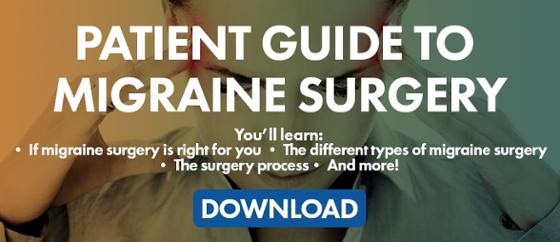Sometimes it feels as if your migraines have no cure and you’ll suffer like this for the rest of your life. It’s a complicated condition with a myriad of causes, so the process of finding out exactly what triggers yours, what type of migraines you have and then hitting on the correct solution can drag on for a while.
Surgery is a viable option in many cases, but there are strict qualifying criteria which we’ll explore here:
Migraine Diagnoses
Migraine is a syndrome with multiple symptoms and causes. To further compound the issue, the syndrome can present a complete list of the possible symptoms, just a few of them, or specific types within groupings of symptoms.
Typically, attacks can last anywhere from a few hours to 72 or more. Accompanying symptoms (apart from the pain) may be nausea and vomiting, sensitivity to sound or light, a tingling or numbness in hands, feet or face, and visual disturbances.
Sufferers often begin with self-medication, not realizing the complexity of this ‘bad headache’ they tend to get. When symptoms become more debilitating, they’ll go and see the doctor for a specialized diagnosis. Pinning pain down to migraine is often difficult because symptoms change not just from person to person, but from attack to attack. Medical tests and close analysis of frequency, duration and pain triggers will eliminate other causes until you finally get an official migraine diagnosis. This is the first step towards being offered surgery.
Non-Surgical Treatments
Next, you need to try non-surgical treatments. These can fall into three categories, and you may be offered one or all of them:
- Acute Treatment: You’ll be given drugs to counteract and relieve the pain when it strikes. There are several different migraine drugs and you may have to experiment a little before you find the one that suits you best.
- Preventative Treatment: Some drugs can be taken daily to ward off migraine attacks before they begin. Preventative drugs can reduce pain intensity and duration if the headache comes.
- Complementary Treatments: You’ll be advised of ways in which diet and relaxation can help prevent migraine onset. Other techniques include biofeedback, acupuncture and exercise.
Treatments are as individual as migraine attacks. What works for one person may have no effect on another, so your own treatment depends on your triggers and migraine patterns. Keeping a migraine diary can help you work closely with your doctors to help devise the most effective plan of action.
If all these attempts to resolve your migraine pain fail, it’s finally time to consider surgical options.
Surgery For Migraines
In days gone by, migraines were put down to hysteria or psychiatric causes. Thankfully, we now know better, and understand that migraines are often caused by nerve pressure, much like carpal tunnel.
- Supra-Orbital Nerve surgery (MISON): relieves pressure on small nerves in your forehead by means of an endoscopy inserted through small incisions above your hairline. It’s minimally invasive, leaves no visible scars and is an outpatient procedure.
- Greater Occipital Nerve Entrapment (MIGONE): This causes pain that starts at the base of the skull and can spread along the sides of the head. Pain behind the eyes is also common. Releasing the trapped nerves at the back of your head can often eliminate migraine pain.
- Septoplasty: Pressure on the nerves can be relieved through this procedure if the cause is a deviated nasal septum. Once the nasal passage is positioned correctly, the lack of nerve pressure can lead to reduced migraine pain. It’s an outpatient procedure, but requires general anesthetic.
- Neurostimulation: This is sometimes used alongside surgical nerve decompression, and is a similar treatment to that used to help spinal injuries, epilepsy and back pain. Small electrodes under the skin stimulate the nerves, preventing them from sending pain signals to your brain.
- Nerve Blocks: This refers to a pain killing injection delivered into the nerve that is causing the migraine, to prevent it from sending pain signals. Lasting longer than ordinary painkillers, it’s a procedure that can help relieve pain while you wait for a different form of surgery, or while you wait for surgical treatment already received to take effect.
When considering surgical migraine treatments and a medical center, bear in mind that following surgery you may feel drowsy and need someone to take you home. It’s best not to drive, and even if you’re using public transport it’s wise to have someone with you.
Consider also your travel expenses, for yourself and your companion, and check on arrival times if you’re using public transport. If you’re traveling some distance from home, there may be overnight accommodation costs, especially since after discharge from the medical center you may need to sleep for several hours before you feel well enough to travel.

